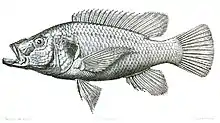Tristramella
Tristramella is a genus of oreochromines, freshwater fishes in the cichlid family. The members of this genus prefer standing waters and their native range is restricted to the Jordan River system, including Lake Tiberias (Kinneret), in Israel and Syria, with introduced populations in a few other places in Syria.[1] Its members are among the few cichlids native to Western Asia, the others being Astatotilapia flaviijosephi, Coptodon zillii, Iranocichla, Oreochromis aureus, O. niloticus and Sarotherodon galilaeus.[2][3]
| Tristramella | |
|---|---|
 | |
| Tristramella sacra | |
| Scientific classification | |
| Kingdom: | Animalia |
| Phylum: | Chordata |
| Class: | Actinopterygii |
| Order: | Cichliformes |
| Family: | Cichlidae |
| Tribe: | Oreochromini |
| Genus: | Tristramella Trewavas, 1942 |
| Type species | |
| Hemichromis sacra Günther, 1865 | |
Locally, T. simonis remains common and an important part of fisheries, but overall it has declined and it is considered threatened.[4] In contrast, T. sacra has been extinct since 1989–90, possibly due to the disappearance of its breeding habitat, marshes in Lake Tiberias.[5]
Tristramella reach up to 25–28 cm (10–11 in) in total length.[6] Overall they resemble typical tilapias and the Tristramella species differ from each other mainly in details of their teeth, the proportional size of their head and the length of their jaw.[7][8] They feed mostly on phyto– and zooplankton, but also take other small invertebrates, tiny fish, macrophytes and detritus. They are mouthbrooders that lay a relatively small number (up to 250) of relatively large eggs.[8] Although hybrids are well-known among tilapias, hybrids between Tristramella and other tilapias are unknown. Despite both living in Lake Tiberias and them being close relatives, hybridization between T. simonis and the now-extinct T. sacra also is not known to have occurred.[9]
The generic name Tristramella honours the English clergyman and naturalist Henry Baker Tristram (1822-1906) who collected cichlids in Palestine for the British Museum of Natural History.[10] In the past they were included in the genus Tilapia instead.[2]
Taxonomy and species
There are currently two recognized species in this genus:[6]
- †Tristramella sacra (Günther, 1865) – long jaw tristramella[5]
- Tristramella simonis (Günther, 1864) – short jaw tristramella[4]
Two other extinct populations, intermidia of Lake Hula and magdelainea of the vicinity of Damascus,[11][12] are of uncertain taxonomic status.[1] In the past, they were recognized as subspecies of T. simonis by FishBase and they are still recognized as valid, separate species by the IUCN, which however has not reviewed their status since 2006.[11][12] Today FishBase and Catalog of Fishes consider both intermidia and magdelainea as synonyms of T. simonis.[6][13]
References
- Borkenhagen, K.; J. Freyhof (2009). "New records of the Levantine endemic cichlid Tristramella simonis from Syria". Cybium. 33 (4): 335–336.
- Shapiro, J.; Z. Snovsky (1997). "The effect of the 1991/1992 winter upon the fishing industry of Lake Kinneret, Israel". Fisheries Management and Ecology. 4 (3): 249–252. doi:10.1046/j.1365-2400.1997.00122.x.
- Werner, N.Y.; O. Mokady (2004). "Swimming out of Africa: mitochondrial DNA evidence for late Pliocene dispersal of a cichlid from Central Africa to the Levant". Biological Journal of the Linnean Society. 82 (1): 103–109. doi:10.1111/j.1095-8312.2004.00321.x.
- Goren, M (2014). "Tristramella simonis". The IUCN Red List of Threatened Species. IUCN. 2014: e.T61362A19010371. doi:10.2305/IUCN.UK.2014-1.RLTS.T61362A19010371.en.
- Goren, M. (2014). "Tristramella sacra". IUCN Red List of Threatened Species. 2014: e.T61372A19010617. doi:10.2305/IUCN.UK.2014-1.RLTS.T61372A19010617.en.
- Froese, Rainer and Pauly, Daniel, eds. (2019). Species of Tristramella in FishBase. November 2019 version.
- Steinitz, H.; A. Ben-Tuvia (1960). "The Cichlid fishes of the genus Tristramella Trewavas". Annals and Magazine of Natural History. 13. 27 (3): 161–175. doi:10.1080/00222936008650912.
- Serruya, C., ed. (1978). Lake Kinneret. Dr. W. Junk bv Publishers, The Hague–Boston–London. pp. 420–424. ISBN 978-94-009-9954-1.
- Kornfield, I.L.; U. Ritte; C. Richler; J. Wahrman (1979). "Biochemical and Cytological Differentiation Among Cichlid Fishes of the Sea of Galilee". Evolution. 33 (1): 1–14. doi:10.2307/2407360. JSTOR 2407360.
- Christopher Scharpf & Kenneth J. Lazara (25 September 2018). "Order CICHLIFORMES: Family CICHLIDAE: Subfamily PSEUDOCRENILABRINAE (p-y)". The ETYFish Project Fish Name Etymology Database. Christopher Scharpf and Kenneth J. Lazara. Retrieved 9 February 2019.
- Goren, M. (2006). "Tristramella intermedia". IUCN Red List of Threatened Species. 2006: e.T60792A12399367. doi:10.2305/IUCN.UK.2006.RLTS.T60792A12399367.en.
- Goren, M. (2006). "Tristramella magdelainae". IUCN Red List of Threatened Species. 2006: e.T61365A12468486. doi:10.2305/IUCN.UK.2006.RLTS.T61365A12468486.en.
- Eschmeyer, William N.; Fricke, Ron & van der Laan, Richard (eds.). "Species in the genus Tristramella". Catalog of Fishes. California Academy of Sciences. Retrieved 9 November 2019.